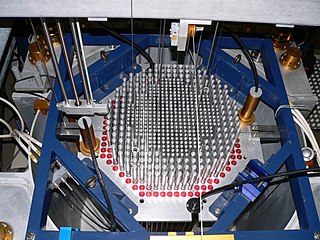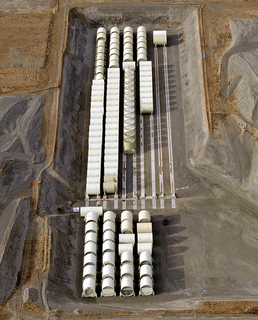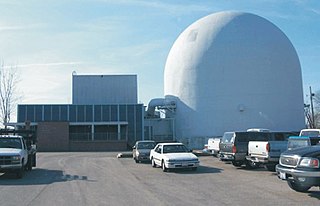
The CANDU is a Canadian pressurized heavy-water reactor design used to generate electric power. The acronym refers to its deuterium oxide moderator and its use of uranium fuel. CANDU reactors were first developed in the late 1950s and 1960s by a partnership between Atomic Energy of Canada Limited (AECL), the Hydro-Electric Power Commission of Ontario, Canadian General Electric, and other companies.

A nuclear reactor, formerly known as an atomic pile, is a device used to initiate and control a fission nuclear chain reaction or nuclear fusion reactions. Nuclear reactors are used at nuclear power plants for electricity generation and in nuclear marine propulsion. Heat from nuclear fission is passed to a working fluid, which in turn runs through steam turbines. These either drive a ship's propellers or turn electrical generators' shafts. Nuclear generated steam in principle can be used for industrial process heat or for district heating. Some reactors are used to produce isotopes for medical and industrial use, or for production of weapons-grade plutonium. As of early 2019, the IAEA reports there are 454 nuclear power reactors and 226 nuclear research reactors in operation around the world.

United States naval reactors are nuclear reactors used by the United States Navy aboard certain ships to generate the steam used to produce power for propulsion, electric power, catapulting airplanes in aircraft carriers, and a few more minor uses. Such naval nuclear reactors have a complete power plant associated with them. All U.S. Navy submarines and supercarriers built since 1975 are nuclear-powered by such reactors. There are no commissioned conventional (non-nuclear) submarines or aircraft carriers left in the U.S. Navy, since the last conventional carrier, USS Kitty Hawk, was decommissioned in May 2009. The U.S. Navy had nine nuclear-powered cruisers with such reactors also, but they have since been decommissioned. Reactors are designed by a variety of contractors, then developed and tested at one of several government owned and prime contractor-operated facilities: Bettis Atomic Power Laboratory in West Mifflin, Pennsylvania and its associated Naval Reactors Facility in Idaho, and Knolls Atomic Power Laboratory in Niskayuna, New York and its associated Kesselring site in West Milton, New York, all under the management of the office of Naval Reactors. Sometimes there were full-scale nuclear-powered prototype plants built at the Naval Reactors Facility, Kesselring, and Windsor to test the nuclear plants, which were operated for years to train nuclear-qualified sailors.

A breeder reactor is a nuclear reactor that generates more fissile material than it consumes. Breeder reactors achieve this because their neutron economy is high enough to create more fissile fuel than they use, by irradiation of a fertile material, such as uranium-238 or thorium-232, that is loaded into the reactor along with fissile fuel. Breeders were at first found attractive because they made more complete use of uranium fuel than light water reactors, but interest declined after the 1960s as more uranium reserves were found, and new methods of uranium enrichment reduced fuel costs.

Superphénix or SPX was a nuclear power station prototype on the Rhône river at Creys-Malville in France, close to the border with Switzerland. Superphénix was a 1,242 MWe fast breeder reactor with the twin goals of reprocessing nuclear fuel from France's line of conventional nuclear reactors, while also being an economical generator of power on its own.

Magnox is a type of nuclear power/production reactor that was designed to run on natural uranium with graphite as the moderator and carbon dioxide gas as the heat exchange coolant. It belongs to the wider class of gas-cooled reactors. The name comes from the magnesium-aluminium alloy used to clad the fuel rods inside the reactor. Like most other "Generation I nuclear reactors", the Magnox was designed with the dual purpose of producing electrical power and plutonium-239 for the nascent nuclear weapons program in Britain. The name refers specifically to the United Kingdom design but is sometimes used generically to refer to any similar reactor.

Dounreay is a small settlement and the site of two large nuclear establishments on the north coast of Caithness in the Highland area of Scotland. It is on the A836 road nine miles west of Thurso.

Gentilly Nuclear Generating Station is a former nuclear power station located on the south shore of the St. Lawrence River in Bécancour, Quebec, 100 km north east of Montreal. The site contained two nuclear reactors; Gentilly-1, a 250 MW CANDU-BWR prototype, was marred by technical problems and shut down in 1977, and Gentilly-2, a 675-MW CANDU-6 reactor operated commercially by the government-owned public utility Hydro-Québec between 1983 and 2012. These were the only power generating nuclear reactors in Quebec.
The Advanced CANDU reactor (ACR), or ACR-1000, was a proposed Generation III+ nuclear reactor design, developed by Atomic Energy of Canada Limited (AECL). It combined features of the existing CANDU pressurised heavy water reactors (PHWR) with features of light-water cooled pressurized water reactors (PWR). From CANDU, it took the heavy water moderator, which gave the design an improved neutron economy that allowed it to burn a variety of fuels. It replaced the heavy water cooling loop with one containing conventional light water, reducing costs. The name refers to its design power in the 1,000 MWe class, with the baseline around 1,200 MWe.
Generation IV reactors are a set of nuclear reactor designs currently being researched for commercial applications by the Generation IV International Forum. They are motivated by a variety of goals including improved safety, sustainability, efficiency, and cost.

The lead-cooled fast reactor is a nuclear reactor design that features a fast neutron spectrum and molten lead or lead-bismuth eutectic coolant. Molten lead or lead-bismuth eutectic can be used as the primary coolant because especially lead, and to a lesser degree bismuth have low neutron absorption and relatively low melting points. Neutrons are slowed less by interaction with these heavy nuclei and therefore, help make this type of reactor a fast-neutron reactor. In simple terms, if a neutron hits a particle with a similar mass (such as hydrogen in a Pressurized Water Reactor PWR, it tends to lose kinetic energy. In contrast, if it hits a much heavier atom such as lead, the neutron will "bounce off" without losing this energy. The coolant does, however, serve as a neutron reflector, returning some escaping neutrons to the core. Fuel designs being explored for this reactor scheme include fertile uranium as a metal, metal oxide or metal nitride. Smaller capacity lead-cooled fast reactors can be cooled by natural convection, while larger designs use forced circulation in normal power operation, but will employ natural circulation emergency cooling. No operator interference is required, nor pumping of any kind to cool the residual heat of the reactor after shutdown. The reactor outlet coolant temperature is typically in the range of 500 to 600 °C, possibly ranging over 800 °C with advanced materials for later designs. Temperatures higher than 800 °C are theoretically high enough to support thermochemical production of hydrogen through the sulfur-iodine cycle, although this has not been demonstrated.
The Steam Generating Heavy Water Reactor (SGHWR) is a United Kingdom design for commercial nuclear reactors. It uses heavy water as the neutron moderator and normal "light" water as the coolant. The coolant boils in the reactor, like a boiling water reactor, and drives the power-extraction steam turbines.
Framatome is a French nuclear reactor business. It is owned by Électricité de France (EDF) (75.5%), Mitsubishi Heavy Industries (19.5%), and Assystem (5%).
Nuclear Power Demonstration was the first Canadian nuclear power reactor, and the prototype for the CANDU reactor design. Built by Canadian General Electric, in partnership with Atomic Energy of Canada Limited (AECL), Ontario Hydro and the US Atomic Energy Commission (AEC), it consisted of a single 22 MWe pressurized heavy water reactor (PHWR) unit located in Rolphton, Ontario, not far from AECL's Chalk River Laboratories. NPD was owned by AECL and operated by Ontario Hydro.

Fermi 1 was the United States' only demonstration-scale breeder reactor, built during the 1950s at the Enrico Fermi Nuclear Generating Station on the western shore of Lake Erie south of Detroit, Michigan. It used the sodium-cooled fast reactor cycle, in which liquid sodium metal is used as the primary coolant instead of more typical nuclear reactor designs which are cooled with water. Sodium cooling allows for a more compact core with surplus neutrons, which are used to produce more fission fuel by converting a surrounding "blanket" of 238U into 239Pu which can be fed back into a reactor. At full power, it would generate 430 MW of heat (MWt), or about 150 MW of electricity (MWe).

Winfrith Atomic Energy Establishment, or AEE Winfrith, was a United Kingdom Atomic Energy Authority site near Winfrith Newburgh in Dorset. It covered an area on Winfrith Heath to the west of the village of Wool between the A352 road and the South West Main Line.

Carolinas–Virginia Tube Reactor (CVTR), also known as Parr Nuclear Station, was an experimental pressurized tube heavy water nuclear power reactor at Parr, South Carolina in Fairfield County. It was built and operated by the Carolinas Virginia Nuclear Power Associates. CVTR was a small test reactor, capable of generating 17 megawatts of electricity. It was officially commissioned in December 1963 and left service in January 1967.

Latina Nuclear Power Plant is a former nuclear power plant at Latina, Lazio, Italy. Consisting of one 153 MWe Magnox reactor, it operated from 1963 until 1987. A second reactor, the experimental CIRENE design, began construction at Latina in 1972 but it was not completed until 1988 and never operated.

Small modular reactors (SMRs) are nuclear fission reactors that are smaller than conventional nuclear reactors and typically have an electrical power output of less than 300 MWe or a thermal power output of less than 1000 MWth.

An organic nuclear reactor, or organic cooled reactor (OCR), is a type of nuclear reactor that uses some form of organic fluid, typically a hydrocarbon substance like polychlorinated biphenyl (PCB), for cooling and sometimes as a neutron moderator as well.














